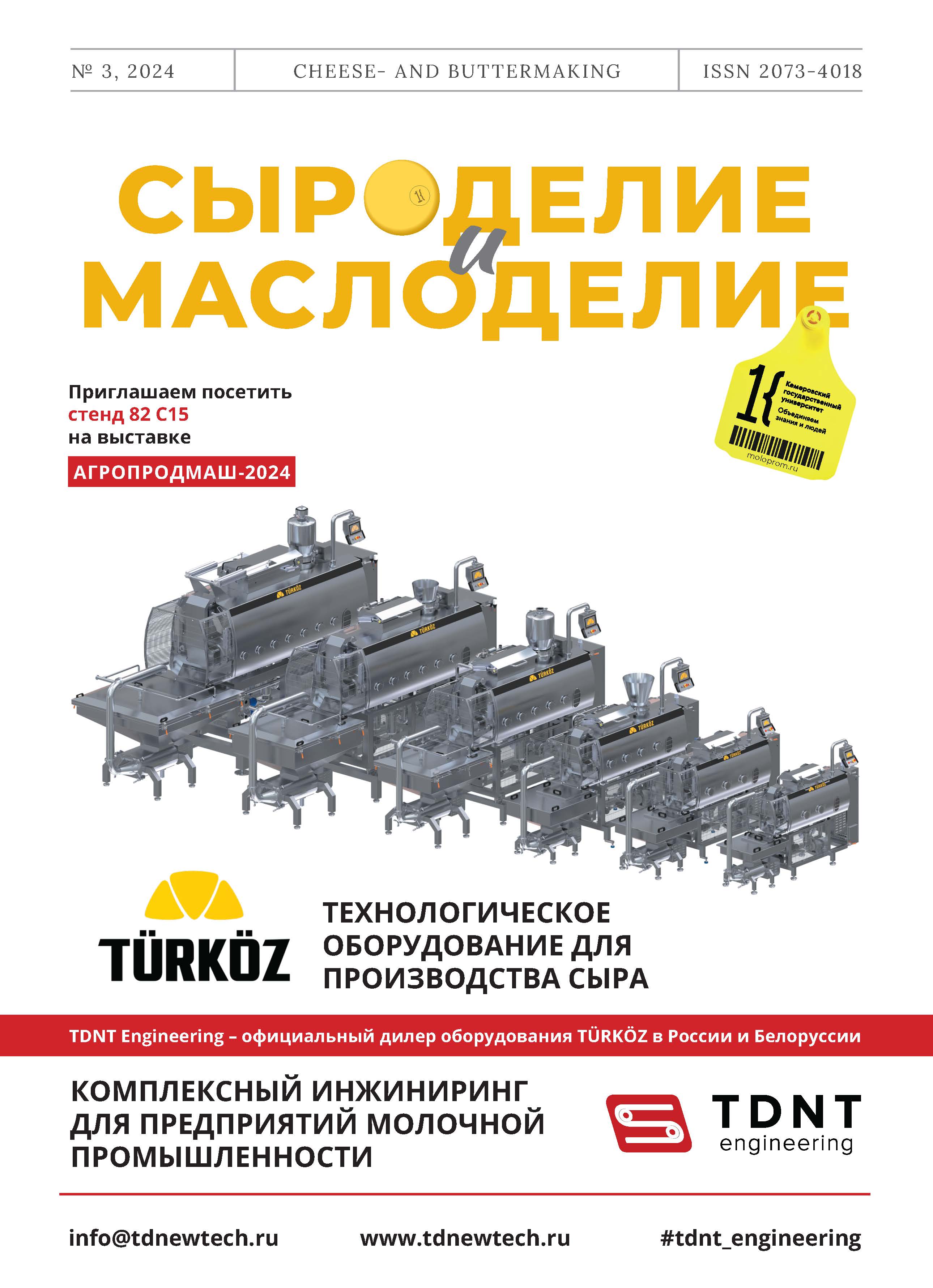Uglich, Russian Federation
Uglich, Russian Federation
Uglich, Russian Federation
Aerobic Bacillus bacteria, yeasts, and micrococci are pigment-forming microorganisms responsible for color defects in cheese production. The article describes their environment, industry-related characteristics, types of defects they cause, and various color violations in commercial cheeses. The research featured domestic cheeses with yellow and red surface spots that appeared during industrial ripening and storage. Pigment-forming microorganisms developed on cheese surface at a low ripening temperature, high concentration of table salt, and critically low oxygen. Pigment-forming microflora proved to enter cheese from milk, brine, or production environment, e.g., water, air, and processing equipment, dry and succulent feeds being the main source of milk contamination with spore-forming aerobic bacteria, yeast, mold fungi, etc. Contamination of raw milk, milking equipment, and air environment with micrococci was primarily associated with cows’ udder and skin. Cheese production presupposes low-temperature heat treatment of raw milk, which means possible residual microflora in pasteurized milk. As a result, the total count of mesophilic aerobic and optionally anaerobic microorganisms, i.e., the potential pigment formers, was to stay below 104 CFU/cm3. Yeast and spore-forming Bacillus microorganisms demonstrated the acceptable level of ≤102 CFU/cm3 in milk intended for cheesemaking. If their total count exceeded 103 CFU/cm3, it indicated high microbiological risks of cheese appearance defects. The microflora responsible for discoloration of cheese surface was represented by yeast, micrococci, aerobic spores, or their combinations.
cheese, spore-forming aerobic microorganisms, micrococci, yeast, spoilage, pigmentation, appearance defects
1. Govindarajan, S. Pink discoloration in Cheddar cheese / S. Govindarajan, H. A. Morris // Journal of Food Science. 2006. Vol. 38. № 4. P. 675–678. http://doi.org/10.1111/j.1365-2621.1973.tb02843.x
2. Daly, D. F. M. Pink discolouration defect in commercial cheese: A review / D. F. M. Daly, P. L. H. McSweeney, J. J. Sheehan // Dairy Science and Technology. 2012. Vol. 92. № 5. P. 439–453. http://doi.org/10.1007/s13594-012-0079-0
3. Martley, F. G. Short communications. Pinkish colouration in Cheddar cheese – description and factors contributing to its formation / F. G. Martley, V. Michel // Journal of Dairy Research. 2001. Vol. 68. P. 327–332. http://doi.org/10.1017/S0022029901004836
4. Gudkov, A. V. Syrodelie: tehnologicheskie, biologicheskie i fiziko-himicheskie aspekty / A. V. Gudkov; pod redakciey S. A. Gudkova. – M.: DeLi print, 2003. – 800 s.
5. Quigley, L. Thermus and the pink discoloration defect in cheese / L. Quigley [et al.] // mSystems. 2016. Vol. 1(3). e00023-16. https://doi.org/10.1128/msystems.00023-16
6. Glazunova, E. G. Biosintez pigmentov u aktinobakteriy Agreia v zavisimosti ot usloviy kul'tivirovaniya / E. G. Glazunova, D. R. Yarullina, I. Yu. Vasil'ev [i dr.] // Uchenye zapiski Kazanskogo universiteta, Estestvennye nauki. 2012. Tom 154, kn. 2. S. 77–84.
7. Abdelaziz, A. A. Pseudomonas aeruginosa’s greenish-blue pigment pyocyanin: its production and biological activities. REVIEW / A. A. Abdelaziz [et al.] // Microbial Cell Factories. 2023. 22:110. https://doi.org/10.1186/s12934-023-02122-1
8. Sivolodskiy, E. P. Sinteticheskaya pitatel'naya sreda King BS dlya opredeleniya sinteza flyuoresceina bakteriyami roda Pseudomonas / E. P. Sivolodskiy // Klinicheskaya laboratornaya diagnostika. 2012. № 10. S. 60–62.
9. Manzo, N. Carbohydrate-active enzymes from pigmented Bacilli: a genomic approach to assess carbohydrate utilization and degradation / N. Manzo [et al.] // BMC Microbiology. 2011. Vol. 11. 198. https://doi.org/10.1186%2F1471-2180-11-198
10. Henriques, A. O. Structure, Assembly, and Function of the Spore Surface Layers / A. O. Henriques, C. P. Moran Jr. // Annual review of microbiology. 2007. Vol. 61. P. 555–588. https://doi.org/10.1146/annurev.micro.61.080706.093224
11. Myunh, G.-D. Mikrobiologiya produktov zhivotnogo proishozhdeniya / G.-D. Myunh [i dr]. – Per. s nem. – M.: Agropromizdat, 1985. – 592 s.
12. Fakhry, S. Characterization of Spore Forming Bacilli Isolated From the Human Gastrointestinal Tract / S. Fakhry [et al.] // Journal of Applied Microbiology. 2008. Vol. 105. P. 2178–2186. http://doi.org/10.1111/j.1365-2672.2008.03934.x
13. Hong, H. A. Bacillus subtilis isolated from the human gastrointestinal tract / H. A. Hong [et al.] // Research in Microbiology. 2009. Vol. 160. P. 134–143. https://doi.org/10.1016/j.resmic.2008.11.002
14. Kharkhota, M. Chromogenicity of aerobic spore‑forming bacteria of the Bacillaceae family isolated from different ecological niches and physiographic zones / M. Kharkhota [et al.] // Brazilian Journal of Microbiology. 2022. Vol. 53 P. 1395–1408. https://doi.org/10.1007/s42770-022-00755-9
15. Sella, S. R. B. R. Bacillus atrophaeus: main characteristics and biotechnological applications – a review / S. R. B. R. Sella, L. P. S. Vandenberghe, C. R. Soccol // Critical Reviews in Biotechnology. Vol. 35 (4). https://doi.org/10.3109/07388551.2014.922915
16. Mitchell, C. Red pigment in Bacillus megaterium spores / C. Mitchell [et al.] // Applied and Environmental Microbiology. 1986. Vol. 52(1). P. 64–67. https://doi.org/10.1128/aem.52.1.64-67.1986
17. Nakamura, L. K. Taxonomic Relationship of Black-Pigmented Bacillus subtilis Strains and a Proposal for Bacillus atrophaeus sp. nov. / L. K. Nakamura // INTERNATIONAL JOURNAL OF SYSTEMATIC BACTERIOLOGY. 1989. Vol. 39 (3). P. 295–300. https://doi.org/10.1099/00207713-39-3-295
18. Sorokulova, I. B. Pigments produced by Bacillus subtilis var. niger 16k. / I. B. Sorokulova, S. R. Reznik // Prikladnaia biokhimiia i mikrobiologiia. 1979. Vol. 15 (2). P. 314–317.
19. Dunlap, C. A. Bacillus nakamurai sp. nov., a black pigment producing strain / C. A. Dunlap [et al.] // International Journal of Systematic and Evolutionary Microbiology. 2016. Vol. 66 (8). P. 2987–2991. https://doi.org/10.1099/ijsem.0.001135
20. Khaneja, R. Carotenoids found in Bacillus / R. Khaneja [et al.] // Journal of Applied Microbiology. 2010. Vol. 108. P. 1889–1902. https://doi.org/10.1111/j.1365-2672.2009.04590.x
21. Duc, L. H. Carotenoids present in halotolerant Bacillus sporeformers / L. H. Duc [et al.] // FEMS Microbiology Letters. 2006. Vol. 255 (2). R. 275–279. https://doi.org/10.1111/j.1574-6968.2005.00091.x
22. Kharkhota, M. Chromogenicity of aerobic spore‑forming bacteria of the Bacillaceae family isolated from different ecological niches and physiographic zones / M. Kharkhota [et al.] // Brazilian Journal of Microbiology. 2022. Vol. 53. P. 1395–1408. https://doi.org/10.1007/s42770-022-00755-9
23. Ritschard, J. S. The Microbial Diversity on the Surface of Smear-Ripened Cheeses and Its Impact on Cheese Quality and Safety / J. S. Ritschard, M. Schuppler // Food. 2024. Vol. 13 (2), 214. https://doi.org/10.3390/foods13020214
24. Bab'eva, I. P. Biologiya drozhzhey / I. P. Bab'eva, I. Yu. Chernov. – M.: Tovarischestvo nauchnyh izdaniy KMK, 2004. – 221 s.
25. Savchik, A. V. Karotinoidsinteziruyuschie drozhzhevye griby i ih primenenie v biotehnologii (obzor literatury) / A. V. Savchik, G. I. Novik // Pischevaya promyshlennost': nauka i tehnologiya. 2020. Tom 13, № 3 (49). S. 70–83. https://www.elibrary.ru/njsecb
26. Hernández-Almanza, A. Rhodotorula glutinis as source of pigments and metabolites for food industry / A. Hernández-Almanza [et al.] // Food Bioscience. 2014. Vol 5. P. 64–72. https://doi.org/10.1016/j.fbio.2013.11.007
27. Cardoso, L. Microbial production of carotenoids A review / L. Cardoso, K. Kanno, S. Karp // AFRICAN JOURNAL OF BIOTECHNOLOGY. 2017. Vol. 16 (4). R. 139–146. https://doi.org/10.5897/AJB2016.15763
28. Yastrebova, O. V. Filogeneticheskoe raznoobrazie bakteriy semeystva Micrococcaceae, vydelennyh iz biotopov s razlichnym antropogennym vozdeystviem / O. V. Yastrebova, E. G. Plotnikova // Vestnik Permskogo universiteta. Ser. Biologiya. 2020. № 4. S. 321–333. https://doi.org/10.17072/1994-9952-2020-4-321-333; https://www.elibrary.ru/xlmhdz
29. Blekbern K. de V. Mikrobiologicheskaya porcha pischevyh produktov / K. de V. Blekbern (red). – Per. s angl. – SPb.: Professiya, 2011. – 784 s.
30. Jagannadham, M. V. The major carotenoid pigment of a psychrotrophic Micrococcus roseus with synthetic membranes / M. V. Jagannadham, V. J. Rao, S. Shivaji // Journal of bacteriology. 1991. Vol. 173 (24). P. 7911–7917. https://doi.org/10.1128%2Fjb.173.24.7911-7917.1991





